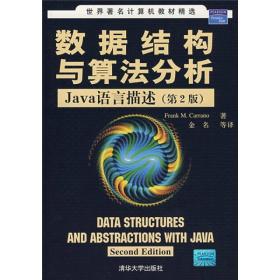
数据结构与算法分析(C++版)(第三版)(英文版)
¥ 10 八五品
仅1件
广东广州
认证卖家担保交易快速发货售后保障
作者・ 著;[美]Clifford、A.、Shaffer、克利福德、Clifford、A.、Shaffer 译
出版社电子工业出版社
出版时间2020-08
版次1
装帧平装
货号9
上书时间2024-11-02
- 最新上架
商品详情
- 品相描述:八五品
图书标准信息
- 作者 ・ 著;[美]Clifford、A.、Shaffer、克利福德、Clifford、A.、Shaffer 译
- 出版社 电子工业出版社
- 出版时间 2020-08
- 版次 1
- ISBN 9787121393549
- 定价 109.00元
- 装帧 平装
- 开本 16开
- 页数 604页
- 字数 1256千字
- 【内容简介】
- 本书采用程序员偏爱的面向对象C++语言来描述数据结构和算法,并把数据结构原理和算法分析技术有机地结合在一起,系统介绍了各种类型的数据结构和排序、检索的各种方法。作者非常注意对每一种数据结构的不同存储方法及有关算法进行分析比较。书中还引入了一些比较高级的数据结构与先进的算法分析技术,并介绍了可计算性理论的一般知识。书中分别给出了C++实现方法和伪码实现方法,便于读者根据情况选择。在作者维护的网站可下载相关代码、编程项目和辅助练习资料。本书已根据作者在网站提供的勘误表进行过内容更正。
- 【作者简介】
-
Clifford A. Shaffer教授于美国马里兰大学获得计算机科学博士学位,在弗吉尼亚理工大学计算机科学系任教超过30年,具有丰富的教学经验,并参与遗传学、生物信息学和计算生物学等交叉项目。著有多本数据结构和算法分析的教材。
Clifford A. Shaffer教授于美国马里兰大学获得计算机科学博士学位,在弗吉尼亚理工大学计算机科学系任教超过30年,具有丰富的教学经验,并参与遗传学、生物信息学和计算生物学等交叉项目。著有多本数据结构和算法分析的教材。 - 【目录】
-
Contents
Part I Preliminaries 预备知识
Chapter 1 Data Structures and Algorithms 数据结构和算法3
1.1 A Philosophy of Data Structures 数据结构的原则4
1.1.1 The Need for Data Structures 学习数据结构的必要性4
1.1.2 Costs and Benefits 代价与效益6
1.2 Abstract Data Types and Data Structures 抽象数据类型和数据结构8
1.3 Design Patterns 设计模式12
1.3.1 Flyweight 享元模式13
1.3.2 Visitor 访问者模式13
1.3.3 Composite 组合模式14
1.3.4 Strategy 策略模式15
1.4 Problems, Algorithms, and Programs 问题、算法和程序16
1.5 Further Reading 深入学习导读18
1.6 Exercises 习题20
Chapter 2 Mathematical Preliminaries 数学预备知识25
2.1 Sets and Relations 集合和关系25
2.2 Miscellaneous Notation 常用数学术语29
2.3 Logarithms 对数31
2.4 Summations and Recurrences 级数求和与递归32
2.5 Recursion 递归36
2.6 Mathematical Proof Techniques 数学证明方法38
2.6.1 Direct Proof 直接证明法39
2.6.2 Proof by Contradiction 反证法39
2.6.3 Proof by Mathematical Induction 数学归纳法40
2.7 Estimation 估计46
2.8 Further Reading 深入学习导读47
2.9 Exercises 习题48
Chapter 3 Algorithm Analysis 算法分析55
3.1 Introduction 概述55
3.2 Best, Worst, and Average Cases 最佳、最差和平均情况61
3.3 A Faster Computer, or a Faster Algorithm 换一台更快的计算机,还是换一种更快的算法62
3.4 Asymptotic Analysis 渐近分析65
3.4.1 Upper Bounds 上限65
3.4.2 Lower Bounds 下限67
3.4.3 Θ Notation Θ表示法68
3.4.4 Simplifying Rules 化简法则69
3.4.5 Classifying Functions 函数分类70
3.5 Calculating the Running Time for a Program 程序运行时间的计算71
3.6 Analyzing Problems 问题的分析76
3.7 Common Misunderstandings 容易混淆的概念77
3.8 Multiple Parameters 多参数问题79
3.9 Space Bounds 空间代价80
3.10 Speeding Up Your Programs 加速你的程序82
3.11 Empirical Analysis 实证分析85
3.12 Further Reading 深入学习导读86
3.13 Exercises 习题86
3.14 Projects 项目设计90
Part II Fundamental Data Structures 基本数据结构
Chapter 4 Lists, Stacks, and Queues 线性表、栈和队列95
4.1 Lists 线性表96
4.1.1 Array-Based List Implementation 顺序表的实现100
4.1.2 Linked Lists 链表103
4.1.3 Comparison of List Implementations 线性表实现方法的比较112
4.1.4 Element Implementations 元素的表示114
4.1.5 Doubly Linked Lists 双链表115
4.2 Stacks 栈120
4.2.1 Array-Based Stacks 顺序栈121
4.2.2 Linked Stacks 链式栈123
4.2.3 Comparison of Array-Based and Linked Stacks 顺序栈与链式栈的比较123
4.2.4 Implementing Recursion 递归的实现125
4.3 Queues 队列127
4.3.1 Array-Based Queues 顺序队列128
4.3.2 Linked Queues 链式队列133
4.3.3 Comparison of Array-Based and Linked Queues 顺序队列与链式队列的比较133
4.4 Dictionaries 字典133
4.5 Further Reading 深入学习导读145
4.6 Exercises 习题145
4.7 Projects 项目设计148
Chapter 5 Binary Trees 二叉树151
5.1 Definitions and Properties 定义及主要特性151
5.1.1 The Full Binary Tree Theorem 满二叉树定理153
5.1.2 A Binary Tree Node ADT 二叉树的抽象数据类型155
5.2 Binary Tree Traversals 遍历二叉树155
5.3 Binary Tree Node Implementations 二叉树的实现160
5.3.1 Pointer-Based Node Implementations 使用指针实现二叉树160
5.3.2 Space Requirements 空间代价166
5.3.3 Array Implementation for Complete Binary Trees 使用数组实现完全二叉树168
5.4 Binary Search Trees 二叉检索树168
5.5 Heaps and Priority Queues 堆与优先队列178
5.6 Huffman Coding Trees Huffman编码树185
5.6.1 Building Huffman Coding Trees 建立Huffman编码树186
5.6.2 Assigning and Using Huffman Codes Huffman编码及其用法192
5.6.3 Search in Huffman Trees 在Huffman树中搜索195
5.7 Further Reading 深入学习导读196
5.8 Exercises 习题196
5.9 Projects 项目设计200
Chapter 6 Non-Binary Trees 树203
6.1 General Tree Definitions and Terminology 树的定义与术语203
6.1.1 An ADT for General Tree Nodes 树结点的ADT204
6.1.2 General Tree Traversals 树的遍历205
6.2 The Parent Pointer Implementation 父指针表示法207
6.3 General Tree Implementations 树的实现213
6.3.1 List of Children 子结点表表示法214
6.3.2 The Left-Child/Right-Sibling Implementation 左子结点/右兄弟结点表示法215
6.3.3 Dynamic Node Implementations 动态结点表示法215
6.3.4 Dynamic “Left-Child/Right-Sibling” Implementation 动态左子结点/右兄弟结点表示法218
6.4 K-ary Trees K叉树218
6.5 Sequential Tree Implementations 树的顺序表示法219
6.6 Further Reading 深入学习导读223
6.7 Exercises 习题223
6.8 Projects 项目设计226
Part III Sorting and Searching 排序与检索
Chapter 7 Internal Sorting 内排序231
7.1 Sorting Terminology and Notation 排序术语232
7.2 Three Θ(n2) Sorting Algorithms 三种代价为Θ(n2)的排序算法233
7.2.1 Insertion Sort 插入排序233
7.2.2 Bubble Sort 冒泡排序235
7.2.3 Selection Sort 选择排序237
7.2.4 The Cost of Exchange Sorting 交换排序算法的时间代价238
7.3 Shellsort Shell排序239
7.4 Mergesort 归并排序241
7.5 Quicksort 快速排序244
7.6 Heapsort 堆排序251
7.7 Binsort and Radix Sort 分配排序和基数排序252
7.8 An Empirical Comparison of Sorting Algorithms 对各种排序算法的实验比较259
7.9 Lower Bounds for Sorting 排序问题的下限261
7.10 Further Reading 深入学习导读265
7.11 Exercises 习题265
7.12 Projects 项目设计269
Chapter 8 File Processing and External Sorting 文件管理和外排序273
8.1 Primary versus Secondary Storage 主存储器和辅助存储器273
8.2 Disk Drives 磁盘276
8.2.1 Disk Drive Architecture 磁盘结构276
8.2.2 Disk Access Costs 磁盘访问代价280
8.3 Buffers and Buffer Pools 缓冲区和缓冲池282
8.4 The Programmer’s View of Files 程序员的文件视图290
8.5 External Sorting 外排序291
8.5.1 Simple Approaches to External Sorting 外排序的简单方法294
8.5.2 Replacement Selection 置换选择排序296
8.5.3 Multiway Merging 多路归并300
8.6 Further Reading 深入学习导读303
8.7 Exercises 习题304
8.8 Projects 项目设计307
Chapter 9 Searching 检索311
9.1 Searching Unsorted and Sorted Arrays 检索未排序和已排序的数组312
9.2 Self-Organizing Lists 自组织线性表317
9.3 Bit Vectors for Representing Sets 集合检索323
9.4 Hashing 散列方法324
9.4.1 Hash Functions 散列函数325
9.4.2 Open Hashing 开散列方法330
9.4.3 Closed Hashing 闭散列方法331
9.4.4 Analysis of Closed Hashing 闭散列方法分析339
9.4.5 Deletion 删除344
9.5 Further Reading 深入学习导读345
9.6 Exercises 习题345
9.7 Projects 项目设计348
Chapter 10 Indexing 索引技术351
10.1 Linear Indexing 线性索引353
10.2 ISAM 索引顺序访问方法356
10.3 Tree-based Indexing 基于树的索引358
10.4 2-3 Trees 2-3树360
10.5 B-Trees B树364
10.5.1 B+-Trees B+树368
10.5.2 B-Tree Analysis B树分析374
10.6 Further Reading 深入学习导读375
10.7 Exercises 习题375
10.8 Projects 项目设计377
Part IV Advanced Data Structures 高级数据结构
Chapter 11 Graphs 图381
11.1 Terminology and Representations 术语和表示法382
11.2 Graph Implementations 图的实现386
11.3 Graph Traversals 图的遍历390
11.3.1 Depth-First Search 深度优先搜索393
11.3.2 Breadth-First Search 广度优先搜索394
11.3.3 Topological Sort 拓扑排序394
11.4 Shortest-Paths Problems 最短路径问题399
11.4.1 Single-Source Shortest Paths 单源最短路径400
11.5 Minimum-Cost Spanning Trees 最小支撑树402
11.5.1 Prim’s Algorithm Prim算法404
11.5.2 Kruskal’s Algorithm Kruskal算法407
11.6 Further Reading 深入学习导读408
11.7 Exercises 习题408
11.8 Projects 项目设计412
Chapter 12 Lists and Arrays Revisited 线性表和数组高级技术415
12.1 Multilists 广义表415
12.2 Matrix Representations 矩阵的表示方法418
12.3 Memory Management 存储管理422
12.3.1 Dynamic Storage Allocation 动态存储分配424
12.3.2 Failure Policies and Garbage Collection 失败处理策略和无用单元收集431
12.4 Further Reading 深入学习导读435
12.5 Exercises 习题436
12.6 Projects 项目设计437
Chapter 13 Advanced Tree Structures 高级树结构439
13.1 Tries Tries结构439
13.2 Balanced Trees 平衡树444
13.2.1 The AVL Tree AVL树445
13.2.2 The Splay Tree 伸展树447
13.3 Spatial Data Structures 空间数据结构450
13.3.1 The k-d Tree k-d树452
13.3.2 The PR quadtree PR四分树457
13.3.3 Other Point Data Structures 其他点状数据结构461
13.3.4 Other Spatial Data Structures 其他空间数据结构463
13.4 Further Reading 深入学习导读463
13.5 Exercises 习题464
13.6 Projects 项目设计465
Part V Theory of Algorithms 算法理论
Chapter 14 Analysis Techniques 分析技术471
14.1 Summation Techniques 求和技术472
14.2 Recurrence Relations 递归关系477
14.2.1 Estimating Upper and Lower Bounds 估算上下限477
14.2.2 Expanding Recurrences 扩展递归480
14.2.3 Divide and Conquer Recurrences 分治法递归482
14.2.4 Average-Case Analysis of Quicksort 快速排序平均情况分析484
14.3 Amortized Analysis 均摊分析486
14.4 Further Reading 深入学习导读489
14.5 Exercises 习题489
14.6 Projects 项目设计493
Chapter 15 Lower Bounds 下限495
15.1 Introduction to Lower Bounds Proofs 下限证明简介496
15.2 Lower Bounds on Searching Lists 线性表检索的下限498
15.2.1 Searching in Unsorted Lists 无序线性表检索498
15.2.2 Searching in Sorted Lists 有序线性表检索500
15.3 Finding the Maximum Value 查找最大值501
15.4 Adversarial Lower Bounds Proofs 对抗性下限证明503
15.5 State Space Lower Bounds Proofs 状态空间下限证明506
15.6 Finding the ith Best Element 查找第i大元素509
15.7 Optimal Sorting 优化排序511
15.8 Further Reading 深入学习导读514
15.9 Exercises 习题514
15.10 Projects 项目设计517
Chapter 16 Patterns of Algorithms 算法模式519
16.1 Dynamic Programming 动态规划519
16.1.1 The Knapsack Problem 背包问题521
16.1.2 All-Pairs Shortest Paths 全局最短路径523
16.2 Randomized Algorithms 随机算法525
16.2.1 Randomized algorithms for finding large values 查找最大值的随机算法525
16.2.2 Skip Lists 跳跃表526
16.3 Numerical Algorithms 数值算法532
16.3.1 Exponentiation 幂运算533
16.3.2 Largest Common Factor 最大公约数533
16.3.3 Matrix Multiplication 矩阵相乘534
16.3.4 Random Numbers 随机数536
16.3.5 The Fast Fourier Transform 快速傅里叶变换537
16.4 Further Reading 深入学习导读542
16.5 Exercises 习题542
16.6 Projects 项目设计543
Chapter 17 Limits to Computation 计算的限制545
17.1 Reductions 归约546
17.2 Hard Problems 难解问题551
17.2.1 The Theory of NP-Completeness NP完全性理论553
17.2.2 NP-Completeness Proofs NP完全性证明557
17.2.3 Coping with NP-Complete Problems 处理NP完全性问题562
17.3 Impossible Problems 不可解问题565
17.3.1 Uncountability 不可数性566
17.3.2 The Halting Problem Is Unsolvable 停机问题的不可解性569
17.4 Further Reading 深入学习导读571
17.5 Exercises 习题572
17.6 Projects 项目设计574
Part VI Appendix 附录
Appendix A Utility Functions 实用函数579
Bibliography 参考文献581
点击展开
点击收起
相关推荐
— 没有更多了 —






























以下为对购买帮助不大的评价